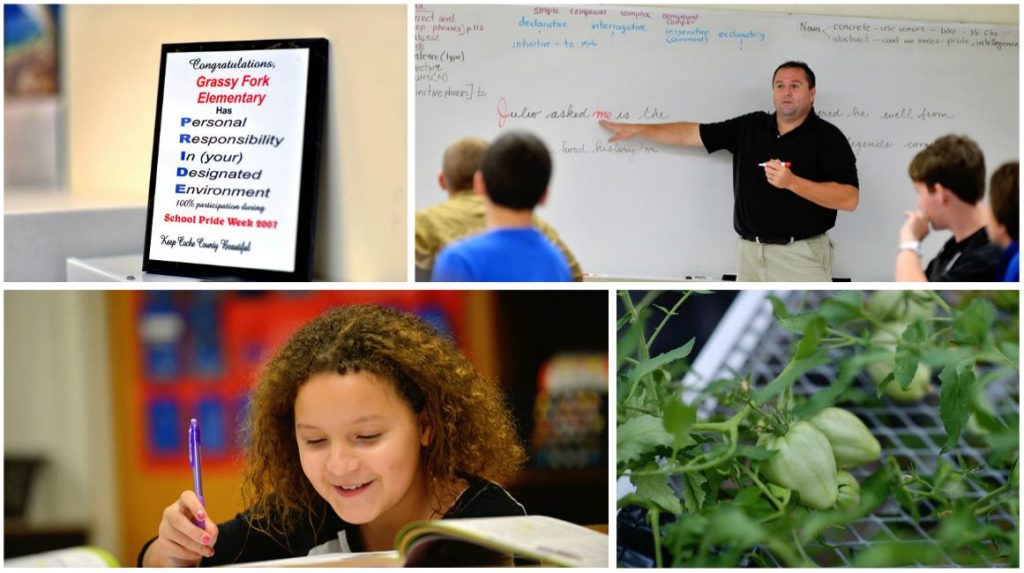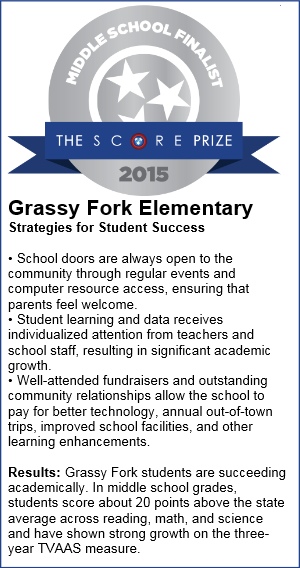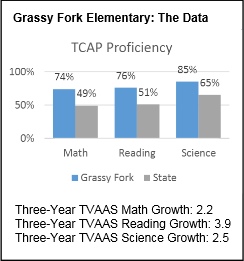
Enrolling at Grassy Fork Elementary, a 2015 SCORE Prize finalist, will be different from the typical new student experience, according to seventh-grader Leah Murray.
“When you first come in, it might feel almost awkward. ‘Who are you? Where did you come from?’ They actually care,” Leah said. “They just kind of welcomed me with open arms. The teachers and the staff make everyone feel special as a person.”
Leah had just moved to the area from Florida. Her new school changed the way she thought about herself.
“I didn’t really know that I was that smart. I thought I was just kind of average,” Leah said. “I learned what it really means to care.”
A consistent, high level of community engagement defines Grassy Fork, helping students complete their best work academically and maintaining a focus on student outcomes in the surrounding community. The school is small – there are around 100 students in grades K-8, including a group of about 30 kids in grades 6-8. It’s situated on a mountain in Cocke County near the unincorporated community of Hartford, on the eastern edge of Tennessee.
At Grassy Fork, a SCORE Prize finalist in the middle school category, students have demonstrated tremendous growth over the last decade. A three-year partnership with the Niswonger Foundation starting in 2002 improved the school’s use of data and instructional differentiation. Now, with a strong academic focus, close-knit culture, and high level of community involvement, Grassy Fork serves kids with innovation and heart. The results are noteworthy – middle school students, for example, score roughly 20 points above the state average across reading, math, and science and have shown strong growth on the three-year TVAAS measure.
Grassy Fork is the essence of a community school, with student learning intertwined with the daily life of area families and residents. Many activities and events in town revolve around the school, including food drives, celebrations, fund-raisers for families in need, and public safety events.
“The school is most definitely the centerpiece of this community,” Grassy Fork teacher Mark Tocholke said. “All activities revolve around the school itself.”
Principal Judy Webb maintains an “open-door policy,” meaning that any community member can come in anytime for a cup of coffee or a fast Internet connection. With low connectivity levels in the mountains – most Grassy Fork students don’t have computers at home – this is an important service.
“Anybody can come in here and research what kind of medicine Grandma needs to take, how to get to Myrtle Beach on MapQuest,” said Dr. Webb. “It’s a hub of communication. Parents do feel welcome here – very welcome here.”
Special events bring families to the school throughout the year, providing monthly opportunities to celebrate what kids are learning. A school picnic in August introduces parents to kids’ teachers and gets the year off to a good start with a 100-foot, soap-covered tarp for sliding. In October, at Spooky Story Night, students write and read original stories aloud in the school’s outdoor classroom. The Family Craft Night in December, a “Bingo for Books” community supper in March, and a bluegrass festival in the spring are just a few other events on the calendar. The events are well attended by school families and community members alike, according to Grassy Fork parent Jennifer Baxter.
“You won’t be able to find a parking spot,” Ms. Baxter said.
This culture translates into valuable community support for the school and students, meeting material needs of the school and its kids while making a meaningful statement that academic work is supported.
Fundraisers including the bluegrass festival and a community Thanksgiving dinner raise thousands of dollars, used to meet needs ranging from technology to textbooks to basketball uniforms. Financial support also allows students to take annual trips to destinations like Nashville and Washington, D.C. Grassy Fork’s outdoor classroom was constructed by a local builder, and a mechanic shop nearby throws pizza parties when kids succeed academically. A community garden at the school was made possible by a grant from the Farm Bureau – it’s watered by a nearby fire department branch, tilled by a neighbor with a tractor, and planted with seeds purchased by the community.
Regular Community Day events at school bring in a wide variety of working people to showcase what they do best. Kids might learn about chinking logs from a cabin-building company, or enjoy a tale told by a storyteller. The events expose them to a variety of walks of life and make connections to the world around them.
“What the children see is that people care about them. They know that so many people really care about them and continue to care about them, even after they graduate high school,” said Dr. Webb. “They really feel the connection to the community and want to help take care of the school and the community.”
About nine out of ten Grassy Fork students are economically disadvantaged, Mr. Tocholke said. “We have some needs here. If a child is hungry, they’re not going to learn well.”
Community members help provide support for needy students. A food bank brings truckloads of food to send home, local ministries provide coats for kids who need them, and other groups make sure students have Christmas presents.
The Grassy Fork community culture extends to each individual student. Individual learning needs are closely monitored by teachers and staff. Innovative after-school programming improves technology access and provides homework help, while helping the school monitor potential problems that could arise between kids, or as a result of the emotional burdens of poverty or drug abuse at home.
Eighth-grade student Kailey Grace says the school is like a family. In contrast to Grassy Fork, the school she used to attend left her feeling left out. She felt that she learned the basics but was poor at math and didn’t do well on state tests. Thanks to one-on-one time with teachers, she’s earning a B in math – and has a completely different attitude about school.
“In this community, there are a lot of children with poor home lives,” said Kailey. “School is a safe environment, so they can really help them grow, because school is a safe place for them. You can tell they want to teach you, so students really want to learn.”
Learn more about the work at Grassy Fork school in this video:
